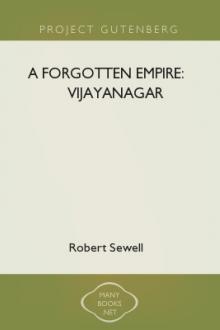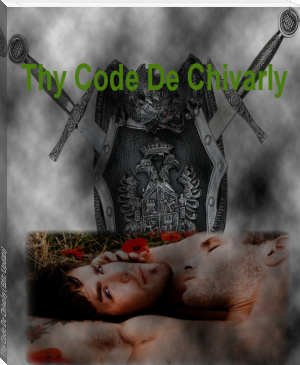A Forgotten Empire: Vijayanagar by Robert Sewell (short story to read TXT) 📕

- Author: Robert Sewell
- Performer: -
Book online «A Forgotten Empire: Vijayanagar by Robert Sewell (short story to read TXT) 📕». Author Robert Sewell
Nevertheless he did not neglect common precautions. His first action was to send his youngest brother, Tirumala, the “Yeltumraj” or “Eeltumraaje” of Firishtah, to the front with 20,000 horse, 100,000 foot, and 500 elephants, to block the passage of the Krishna at all points. Next he despatched his second brother, Venkatadri, with another large army; and finally marched in person towards the point of attack with the whole power of the Vijayanagar empire. The forces were made up of large drafts from all the provinces — Canarese and Telugus of the frontier, Mysoreans and Malabarese from the west and centre, mixed with the Tamils from the remoter districts to the south; each detachment under its own local leaders, and forming part of the levies of the temporary provincial chieftain appointed by the crown. According to Couto, they numbered 600,000 foot and 100,000 horse. His adversaries had about half that number. As to their appearance and armament, we may turn for information to the description given us by Paes of the great review of which he was an eye-witness forty-five years earlier at Vijayanagar,[325] remembering always that the splendid troops between whose lines he then passed in the king’s procession were probably the ELITE of the army, and that the common soldiers were clad in the lightest of working clothes, many perhaps with hardly any clothes at all, and armed only with spear or dagger.[326]
The allies had perhaps halted too long. At any rate, their scouts returned to their sovereigns with the news that all the passages of the river were defended, and that their only course was to force the ford immediately in their front. This was in possession of the Hindus, who had fortified the banks on the south side, had thrown up earthworks, and had stationed a number of cannon to dispute the crossing.
The defenders of the ford anxiously awaited intelligence of their enemy’s movements, and learning that he had struck his camp and marched along the course of the river, they quitted their post and followed, keeping always to the south bank in readiness to repel any attempt to cross directly in their front. This manoeuvre, a ruse on the part of the Mussulmans, was repeated on three successive days. On the third night the Sultans hastily left their camp, returned to the ford, and, finding it deserted, crossed with a large force. This movement covered the transit of the whole of their army, and enabled them to march southwards to the attack of Rama Raya’s main body.
Rama Raya, though surprised, was not alarmed, and took all possible measures for defence. In the morning the enemy was within ten miles of his camp, and Venkatadri and Tirumala succeeded in effecting a junction with their brother.
On the following day, Tuesday, January 23; 1565,[327] both sides having made their dispositions, a pitched battle took place328 in which all the available forces of both sides were engaged. In one of his descriptions Firishtah estimates the Vijayanagar army alone as amounting to 900,000 infantry, 45,000 cavalry, and 2000 elephants, besides 15,000 auxiliaries; but he himself varies so greatly in the numbers he gives in different parts of his narrative that there is no necessity to accept these figures as accurate. There can be little doubt, however, that the numbers were very large. The Hindu left, on the west, was entrusted to the command of Tirumala; Rama Raya in person was in the centre, and the right was composed of the troops of Venkatadri. Opposed to Tirumala were the forces of Bijapur under their Sultan Ali Adil; the Mussalman centre was under the command of Hussain Nizam Shah; and the left of the allied army, in Venkatadri’s front, consisted of the forces brought from Ahmadabad and Golkonda by the two Sultans, Ali Barid and Ibrahim Qutb. The allied forces drew up in a long line with their artillery in the centre, and awaited the enemy’s attack, each division with the standards of the twelve Imams waving in the van. The Nizam Shah’s front was covered by six hundred pieces of ordnance disposed in three lines, in the first of which were heavy guns, then the smaller ones, with light swivel guns in the rear. In order to mask this disposition two thousand foreign archers were thrown out in front, who kept up a heavy discharge as the enemy’s line came on. The archers fell back as the Hindus of Rama’s division approached, and the batteries opened with such murderous effect that the assailants retreated in confusion and with great loss.
Rama Rajah was now a very old man — Couto says “he was ninety-six years old, but as brave as a man of thirty” — and, against the entreaties of his officers, he preferred to superintend operations from a litter rather than remain for a long time mounted — a dangerous proceeding, since in case of a reverse a rapid retreat was rendered impossible. But he could not be induced to change his mind, remarking that in spite of their brave show the enemy were children and would soon be put to flight. So confident was he of victory that it is said he had ordered his men to bring him the head of Hussain Nizam, but to capture the Adil Shah and Ibrahim of Golkonda alive, that he might keep them the rest of their lives in iron cages.
The battle becoming more general, the Hindus opened a desolating fire from a number of field-pieces and rocket-batteries. The left and right of the Muhammadan line were pressed back after destructive hand-to-hand fighting, many falling on both sides. At this juncture Rama Raya, thinking to encourage his men, descended from his litter and seated himself on a “rich throne set with jewels, under a canopy of crimson velvet, embroidered with gold and adorned with fringes of pearls,” ordering his treasurer to place heaps of money all round him, so that he might confer rewards on such of his followers as deserved his attention. “There were also ornaments of gold and jewels placed for the same purpose.” A second attack by the Hindus on the guns in the centre seemed likely to complete the overthrow of the whole Muhammadan line, when the front rank of pieces was fired at close quarters, charged with bags of copper money; and this proved so destructive that 5000 Hindus were left dead on the field in front of the batteries. This vigorous policy threw the Hindu centre into confusion, upon which 5000 Muhammadan cavalry charged through the intervals of the guns and cut their way into the midst of the disorganised masses, towards the spot where the Raya had taken post. He had again changed his position and ascended his litter; but hardly had he done so when an elephant belonging to the Nizam Shah, wild with the excitement of the battle, dashed forward towards him, and the litter-bearers let fall their precious burden in terror at the animal’s approach. Before he had time to recover himself and mount a horse, a body of the allies was upon him, and he was seized and taken prisoner.
This event threw the Hindus into a panic, and they began to give way. Rama Raya was conducted by the officer who commanded the artillery of Hussain Nizam to his Sultan, who immediately ordered his captive to be decapitated, and the head to be elevated on a long spear, so that it might be visible to the Hindu troops.
On seeing that their chief was dead, the Vijayanagar forces broke and fled “They were pursued by the allies with such successful slaughter that the river which ran near the field was dyed red with their blood. It is computed on the best authorities that above one hundred thousand infidels were slain in fight and during the pursuit.”
The Mussulmans were thus completely victorious, and the Hindus fled towards the capital; but so great was the confusion that there was not the slightest attempt made to take up a new and defensive position amongst the hills surrounding the city, or even to defend the walls or the approaches. The rout was complete.
“The plunder was so great that every private man in the allied army became rich in gold, jewels, effects, tents, arms, horses, and slaves, as the sultans left every person in possession of what he had acquired, only taking elephants for their own use.”
De Couto, describing the death of Rama Raya, states329 that Hussain Nizam Shah cut off his enemy’s head with his own hand, exclaiming, “Now I am avenged of thee! Let God do what he will to me!” The Adil Shah, on the contrary, was greatly distressed at Rama Raya’s death.[330]
The story of this terrible disaster travelled apace to the city of Vijayanagar. The inhabitants, unconscious of danger, were living in utter ignorance that any serious reverse had taken place; for their leaders had marched out with countless numbers in their train, and had been full of confidence as to the result. Suddenly, however, came the bad news. The army was defeated; the chiefs slain; the troops in retreat. But still they did not grasp the magnitude of the reverse; on all previous occasions the enemy had been either driven back, or bought off with presents from the overstocked treasury of the kings. There was little fear, therefore, for the city itself. That surely was safe! But now came the dejected soldiers hurrying back from the fight, and amongst the foremost the panic-stricken princes of the royal house. Within a few hours these craven chiefs hastily left the palace, carrying with them all the treasures on which they could lay their hands. Five hundred and fifty elephants, laden with treasure in gold, diamonds, and precious stones valued at more than a hundred millions sterling, and carrying the state insignia and the celebrated jewelled throne of the kings, left the city under convoy of bodies of soldiers who remained true to the crown. King Sadasiva was carried off by his jailor, Tirumala, now sole regent since the death of his brothers; and in long line the royal family and their followers fled southward towards the fortress of Penukonda.
Then a panic seized the city. The truth became at last apparent. This was not a defeat merely, it was a cataclysm. All hope was gone. The myriad dwellers in the city were left defenceless. No retreat, no flight was possible except to a few, for the pack-oxen and carts had almost all followed the forces to the war, and they had not returned. Nothing could be done but to bury all treasures, to arm the younger men, and to wait. Next day the place became a prey to the robber tribes and jungle people of the neighbourhood. Hordes of Brinjaris, Lambadis, Kurubas, and the like,[331] pounced down on the hapless city and looted the stores and shops, carrying off great quantities of riches. Couto states that there were six concerted attacks by these people during the day.
The third day332 saw the beginning of the end. The victorious Mussulmans had halted on the field of battle for rest and refreshment, but now they had reached the capital, and from that time forward for a space of five months Vijayanagar knew no rest. The enemy had come to destroy, and they carried out their object





Comments (0)